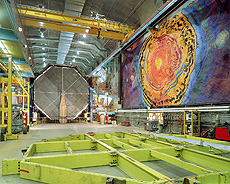MINOS reports new measurement of neutrino velocity
 |
Scientists at the MINOS experiment measure neutrinos that travel 450 miles through the earth. They travel first through a detector at Fermilab and then through a second detector, pictured here, in a mine in Soudan, Minn. Photo: Fermilab
|
Scientists from Fermilab's MINOS experiment are reporting a new measurement of the velocity of the neutrino.
The neutrino, which is the lightest known particle, is expected to move so close to the speed of light that experiments use it as a point of comparison and expect any deviations to be extremely small.
Last September the OPERA experiment in Gran Sasso, Italy, announced a deviation much greater than could be explained by the theory of special relativity. The experiment later identified two possible effects that could have an influence on its neutrino timing measurement. In March, the ICARUS experiment in Gran Sasso measured the neutrino's velocity to be consistent with the speed of light.
The new MINOS measurement, presented yesterday by Fermilab's Phil Adamson at the XXV International Conference on Neutrino Physics and Astrophysics in Kyoto, Japan (Neutrino 2012), uses seven years of data taken by the MINOS experiment. This extends an earlier published study by MINOS using a factor of 8.5 more data.
Most importantly, the new MINOS study significantly reduces the systematic errors of its earlier work with detailed measurements of the behavior of the experiment's GPS timing system, improved understanding of the delays of electronic components at every stage of the MINOS detectors and the use of upgraded timing equipment, designed and implemented with the assistance of the National Institute of Science and Technology and the United States Naval Observatory.
Applying these improved understandings, the MINOS collaboration measures a neutrino arrival time for travel between Fermilab and Soudan, Minn., that is consistent with the expected travel time at the speed of light. The difference between the measured and calculated times is -15 ± 31 nanoseconds, indicating no observable effect. The measurement supports the theoretically predicted time of flight and is consistent with the ICARUS measurement.
"This measurement required MINOS to study the behavior of our timing system over a period of years of previous data," said Fermilab's Rob Plunkett, MINOS co-spokesperson. "Improved analysis techniques, intensive re-measurement of the detector and new timing standards from national timing experts all played a role."
A unique feature of the new result is the use of auxiliary timing detectors with very well-understood performance. After calibration at Fermilab, identical copies of these small scintillator detectors were used at MINOS's two detectors to characterize internal delays in a way that systematic errors in the detectors and equipment largely cancel.
The next phase of the MINOS experiment, which will search for a fourth neutrino, will also be capable of measuring neutrino velocities with a precision of between 2 and 5 ns.
—Leah Hesla
|